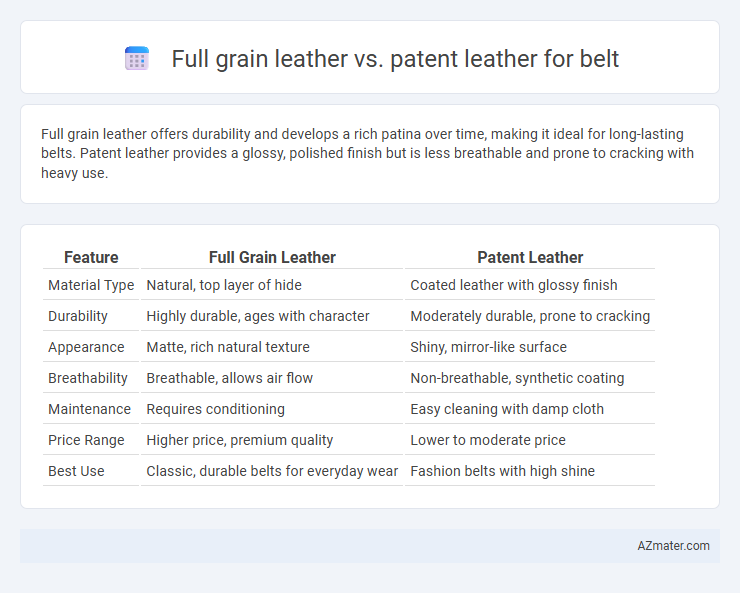Full grain leather offers durability and develops a rich patina over time, making it ideal for long-lasting belts. Patent leather provides a glossy, polished finish but is less breathable and prone to cracking with heavy use.
Table of Comparison
| Feature | Full Grain Leather | Patent Leather |
|---|---|---|
| Material Type | Natural, top layer of hide | Coated leather with glossy finish |
| Durability | Highly durable, ages with character | Moderately durable, prone to cracking |
| Appearance | Matte, rich natural texture | Shiny, mirror-like surface |
| Breathability | Breathable, allows air flow | Non-breathable, synthetic coating |
| Maintenance | Requires conditioning | Easy cleaning with damp cloth |
| Price Range | Higher price, premium quality | Lower to moderate price |
| Best Use | Classic, durable belts for everyday wear | Fashion belts with high shine |
Introduction to Full Grain Leather and Patent Leather
Full grain leather, known for its durability and natural texture, is made from the top layer of the hide, retaining the original grain and imperfections that enhance its strength and aging characteristics. Patent leather features a smooth, glossy finish achieved through a high-gloss coating, offering a sleek and polished look but with less breathability compared to full grain leather. Both materials serve distinct purposes in belt design, with full grain leather prized for longevity and a classic appearance, while patent leather is favored for formal occasions due to its shiny and reflective surface.
Key Characteristics of Full Grain Leather
Full grain leather, renowned for its durability and natural texture, retains the top layer of the hide, including all the grain, making it the strongest and most breathable leather type for belts. This material develops a rich patina over time, enhancing its aesthetic appeal and uniqueness with wear. In contrast to patent leather's shiny, coated surface, full grain leather offers a matte finish and exceptional resistance to wear, ensuring long-lasting comfort and strength.
Defining Features of Patent Leather
Patent leather is characterized by its glossy, mirror-like finish achieved through a coating process that seals the leather surface, providing a smooth and highly polished appearance. Unlike full grain leather, which retains the natural texture and breathability of the hide, patent leather is more resistant to moisture and stains but less flexible and breathable. This makes patent leather ideal for belts intended for formal wear where a sleek, shiny look is desired, contrasting with the durability and natural aging of full grain leather belts.
Durability Comparison: Full Grain vs. Patent Leather
Full grain leather is renowned for its superior durability, resisting wear and developing a rich patina over time, making it ideal for long-lasting belts. Patent leather, while visually striking with its glossy finish, is more prone to cracking and scuffing, reducing its lifespan under frequent use. Choosing full grain leather ensures a belt that withstands daily wear far better than the delicate surface of patent leather.
Aesthetic Appeal: Natural vs. Glossy Finish
Full grain leather belts offer a natural, rugged aesthetic with visible grain patterns and subtle imperfections that enhance their unique character over time. Patent leather belts provide a glossy, high-shine finish that delivers a sleek, polished look ideal for formal occasions. The choice between full grain and patent leather ultimately depends on preference for a timeless, organic appeal versus a bold, reflective surface.
Comfort and Flexibility Analysis
Full grain leather belts offer superior comfort and flexibility due to their natural fiber structure, which softens and molds to the wearer's body over time. Patent leather belts, with their glossy, coated surface, tend to be stiffer and less breathable, often causing discomfort during prolonged wear. The inherent durability and breathability of full grain leather make it a preferred choice for users seeking long-lasting comfort and flexible fit.
Maintenance and Care Requirements
Full grain leather belts demand regular conditioning with natural oils or specialized leather conditioners to maintain suppleness and prevent cracking, alongside gentle cleaning to remove dirt. Patent leather belts require less hydration but need careful handling to avoid scratches and can be cleaned effectively with a damp cloth and mild soap, followed by buffing to retain their glossy finish. Both benefit from proper storage away from direct sunlight and moisture to extend lifespan and preserve appearance.
Price Differences and Value for Money
Full grain leather belts offer superior durability and develop a rich patina over time, commanding higher prices due to their premium quality and natural finish. Patent leather belts, characterized by their glossy, coated surface, are generally more affordable but tend to be less durable and prone to cracking. For value-conscious buyers, full grain leather provides long-term worth through enhanced longevity, while patent leather suits budget needs with a stylish appearance for occasional wear.
Suitable Occasions and Style Recommendations
Full grain leather belts offer a classic, durable option ideal for formal and business settings, pairing well with suits and dress shoes due to their natural texture and rich patina. Patent leather belts provide a glossy, polished finish suitable for evening events, weddings, or parties, complementing tuxedos and sleek dress attire with a sophisticated, eye-catching shine. Choosing between full grain and patent leather depends on the occasion's formality and desired style, with full grain emphasizing timeless elegance and patent leather highlighting bold, modern glamour.
Final Verdict: Choosing the Right Leather for Your Belt
Full grain leather offers unparalleled durability, natural texture, and ages gracefully, making it ideal for belts that require long-lasting strength and a classic appearance. Patent leather, known for its glossy, polished finish, suits formal belts and occasions where style and shine are prioritized over ruggedness. Selecting the right leather depends on lifestyle needs: full grain for everyday wear and resilience, patent leather for smart, stylish statements.

Infographic: Full grain leather vs Patent leather for Belt
 azmater.com
azmater.com